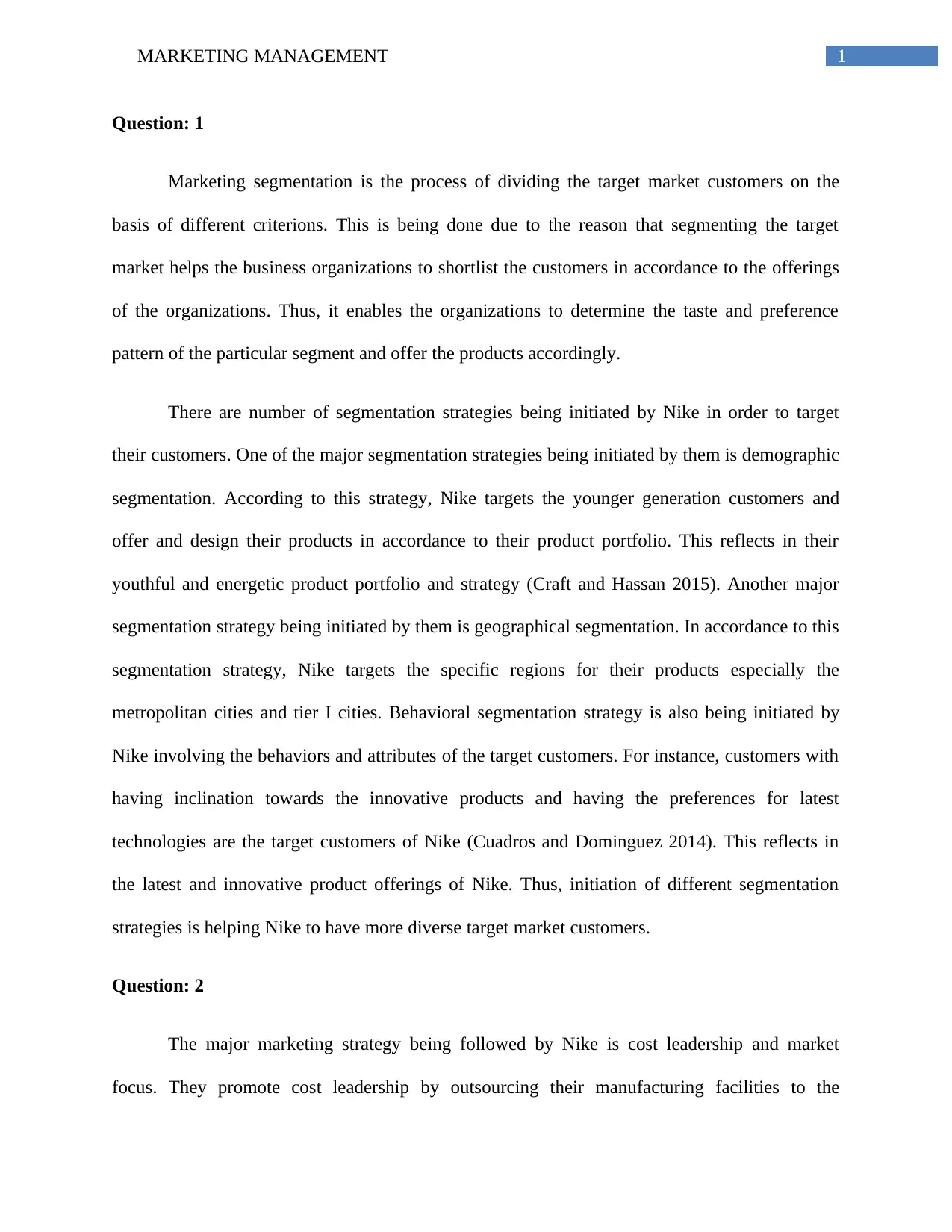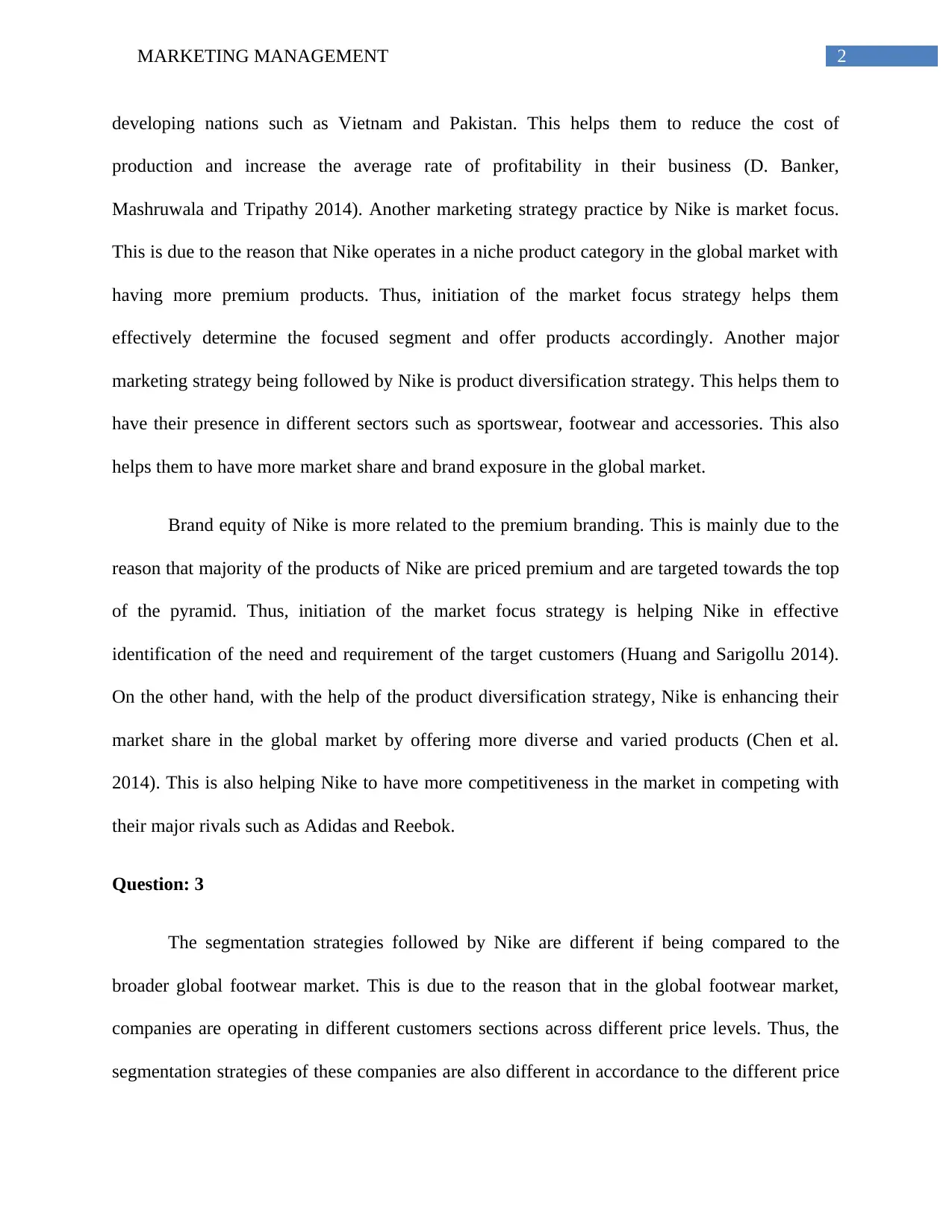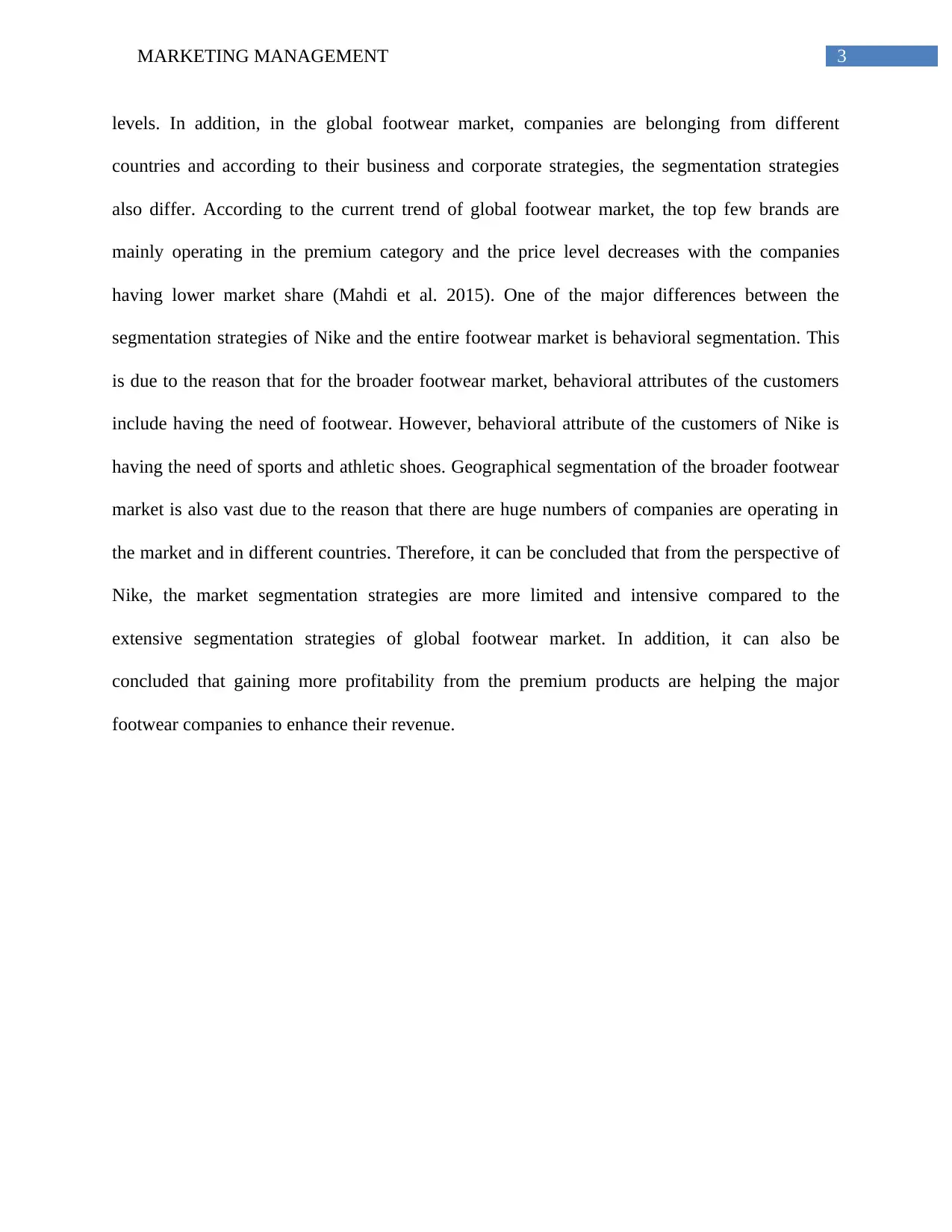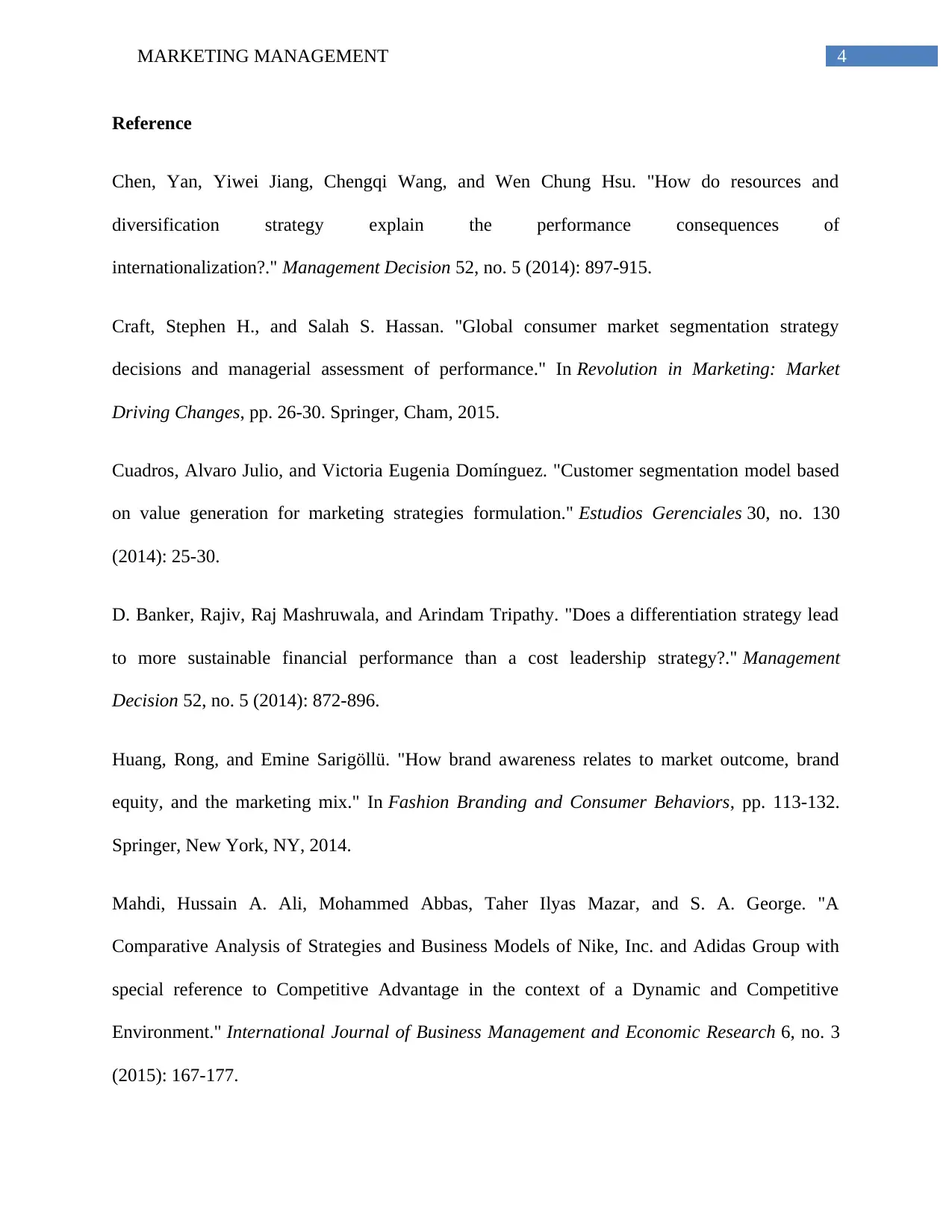Analyzing Nike's Marketing Management: Segmentation and Brand Equity
VerifiedAdded on 2023/06/11
|6
|1171
|68
Report
AI Summary
This report provides a detailed analysis of Nike's marketing management strategies, focusing on segmentation, market focus, and product diversification. It examines how Nike utilizes demographic, geographic, and behavioral segmentation to target diverse customer groups. The report also highlights Nike's cost leadership and market focus strategies, achieved through outsourcing and premium branding. Furthermore, it compares Nike's segmentation strategies with those of the broader global footwear market, noting the differences in behavioral and geographical segmentation. The analysis emphasizes how Nike's premium product positioning and product diversification contribute to its competitiveness and market share, particularly against rivals like Adidas and Reebok. This student-contributed document is available on Desklib, a platform offering a wide range of study resources for students.

Running head: MARKETING MANAGEMENT
Marketing management
Name of the student
Name of the University
Author note
Marketing management
Name of the student
Name of the University
Author note
Paraphrase This Document
Need a fresh take? Get an instant paraphrase of this document with our AI Paraphraser

1MARKETING MANAGEMENT
Question: 1
Marketing segmentation is the process of dividing the target market customers on the
basis of different criterions. This is being done due to the reason that segmenting the target
market helps the business organizations to shortlist the customers in accordance to the offerings
of the organizations. Thus, it enables the organizations to determine the taste and preference
pattern of the particular segment and offer the products accordingly.
There are number of segmentation strategies being initiated by Nike in order to target
their customers. One of the major segmentation strategies being initiated by them is demographic
segmentation. According to this strategy, Nike targets the younger generation customers and
offer and design their products in accordance to their product portfolio. This reflects in their
youthful and energetic product portfolio and strategy (Craft and Hassan 2015). Another major
segmentation strategy being initiated by them is geographical segmentation. In accordance to this
segmentation strategy, Nike targets the specific regions for their products especially the
metropolitan cities and tier I cities. Behavioral segmentation strategy is also being initiated by
Nike involving the behaviors and attributes of the target customers. For instance, customers with
having inclination towards the innovative products and having the preferences for latest
technologies are the target customers of Nike (Cuadros and Dominguez 2014). This reflects in
the latest and innovative product offerings of Nike. Thus, initiation of different segmentation
strategies is helping Nike to have more diverse target market customers.
Question: 2
The major marketing strategy being followed by Nike is cost leadership and market
focus. They promote cost leadership by outsourcing their manufacturing facilities to the
Question: 1
Marketing segmentation is the process of dividing the target market customers on the
basis of different criterions. This is being done due to the reason that segmenting the target
market helps the business organizations to shortlist the customers in accordance to the offerings
of the organizations. Thus, it enables the organizations to determine the taste and preference
pattern of the particular segment and offer the products accordingly.
There are number of segmentation strategies being initiated by Nike in order to target
their customers. One of the major segmentation strategies being initiated by them is demographic
segmentation. According to this strategy, Nike targets the younger generation customers and
offer and design their products in accordance to their product portfolio. This reflects in their
youthful and energetic product portfolio and strategy (Craft and Hassan 2015). Another major
segmentation strategy being initiated by them is geographical segmentation. In accordance to this
segmentation strategy, Nike targets the specific regions for their products especially the
metropolitan cities and tier I cities. Behavioral segmentation strategy is also being initiated by
Nike involving the behaviors and attributes of the target customers. For instance, customers with
having inclination towards the innovative products and having the preferences for latest
technologies are the target customers of Nike (Cuadros and Dominguez 2014). This reflects in
the latest and innovative product offerings of Nike. Thus, initiation of different segmentation
strategies is helping Nike to have more diverse target market customers.
Question: 2
The major marketing strategy being followed by Nike is cost leadership and market
focus. They promote cost leadership by outsourcing their manufacturing facilities to the

2MARKETING MANAGEMENT
developing nations such as Vietnam and Pakistan. This helps them to reduce the cost of
production and increase the average rate of profitability in their business (D. Banker,
Mashruwala and Tripathy 2014). Another marketing strategy practice by Nike is market focus.
This is due to the reason that Nike operates in a niche product category in the global market with
having more premium products. Thus, initiation of the market focus strategy helps them
effectively determine the focused segment and offer products accordingly. Another major
marketing strategy being followed by Nike is product diversification strategy. This helps them to
have their presence in different sectors such as sportswear, footwear and accessories. This also
helps them to have more market share and brand exposure in the global market.
Brand equity of Nike is more related to the premium branding. This is mainly due to the
reason that majority of the products of Nike are priced premium and are targeted towards the top
of the pyramid. Thus, initiation of the market focus strategy is helping Nike in effective
identification of the need and requirement of the target customers (Huang and Sarigollu 2014).
On the other hand, with the help of the product diversification strategy, Nike is enhancing their
market share in the global market by offering more diverse and varied products (Chen et al.
2014). This is also helping Nike to have more competitiveness in the market in competing with
their major rivals such as Adidas and Reebok.
Question: 3
The segmentation strategies followed by Nike are different if being compared to the
broader global footwear market. This is due to the reason that in the global footwear market,
companies are operating in different customers sections across different price levels. Thus, the
segmentation strategies of these companies are also different in accordance to the different price
developing nations such as Vietnam and Pakistan. This helps them to reduce the cost of
production and increase the average rate of profitability in their business (D. Banker,
Mashruwala and Tripathy 2014). Another marketing strategy practice by Nike is market focus.
This is due to the reason that Nike operates in a niche product category in the global market with
having more premium products. Thus, initiation of the market focus strategy helps them
effectively determine the focused segment and offer products accordingly. Another major
marketing strategy being followed by Nike is product diversification strategy. This helps them to
have their presence in different sectors such as sportswear, footwear and accessories. This also
helps them to have more market share and brand exposure in the global market.
Brand equity of Nike is more related to the premium branding. This is mainly due to the
reason that majority of the products of Nike are priced premium and are targeted towards the top
of the pyramid. Thus, initiation of the market focus strategy is helping Nike in effective
identification of the need and requirement of the target customers (Huang and Sarigollu 2014).
On the other hand, with the help of the product diversification strategy, Nike is enhancing their
market share in the global market by offering more diverse and varied products (Chen et al.
2014). This is also helping Nike to have more competitiveness in the market in competing with
their major rivals such as Adidas and Reebok.
Question: 3
The segmentation strategies followed by Nike are different if being compared to the
broader global footwear market. This is due to the reason that in the global footwear market,
companies are operating in different customers sections across different price levels. Thus, the
segmentation strategies of these companies are also different in accordance to the different price
⊘ This is a preview!⊘
Do you want full access?
Subscribe today to unlock all pages.

Trusted by 1+ million students worldwide

3MARKETING MANAGEMENT
levels. In addition, in the global footwear market, companies are belonging from different
countries and according to their business and corporate strategies, the segmentation strategies
also differ. According to the current trend of global footwear market, the top few brands are
mainly operating in the premium category and the price level decreases with the companies
having lower market share (Mahdi et al. 2015). One of the major differences between the
segmentation strategies of Nike and the entire footwear market is behavioral segmentation. This
is due to the reason that for the broader footwear market, behavioral attributes of the customers
include having the need of footwear. However, behavioral attribute of the customers of Nike is
having the need of sports and athletic shoes. Geographical segmentation of the broader footwear
market is also vast due to the reason that there are huge numbers of companies are operating in
the market and in different countries. Therefore, it can be concluded that from the perspective of
Nike, the market segmentation strategies are more limited and intensive compared to the
extensive segmentation strategies of global footwear market. In addition, it can also be
concluded that gaining more profitability from the premium products are helping the major
footwear companies to enhance their revenue.
levels. In addition, in the global footwear market, companies are belonging from different
countries and according to their business and corporate strategies, the segmentation strategies
also differ. According to the current trend of global footwear market, the top few brands are
mainly operating in the premium category and the price level decreases with the companies
having lower market share (Mahdi et al. 2015). One of the major differences between the
segmentation strategies of Nike and the entire footwear market is behavioral segmentation. This
is due to the reason that for the broader footwear market, behavioral attributes of the customers
include having the need of footwear. However, behavioral attribute of the customers of Nike is
having the need of sports and athletic shoes. Geographical segmentation of the broader footwear
market is also vast due to the reason that there are huge numbers of companies are operating in
the market and in different countries. Therefore, it can be concluded that from the perspective of
Nike, the market segmentation strategies are more limited and intensive compared to the
extensive segmentation strategies of global footwear market. In addition, it can also be
concluded that gaining more profitability from the premium products are helping the major
footwear companies to enhance their revenue.
Paraphrase This Document
Need a fresh take? Get an instant paraphrase of this document with our AI Paraphraser

4MARKETING MANAGEMENT
Reference
Chen, Yan, Yiwei Jiang, Chengqi Wang, and Wen Chung Hsu. "How do resources and
diversification strategy explain the performance consequences of
internationalization?." Management Decision 52, no. 5 (2014): 897-915.
Craft, Stephen H., and Salah S. Hassan. "Global consumer market segmentation strategy
decisions and managerial assessment of performance." In Revolution in Marketing: Market
Driving Changes, pp. 26-30. Springer, Cham, 2015.
Cuadros, Alvaro Julio, and Victoria Eugenia Domínguez. "Customer segmentation model based
on value generation for marketing strategies formulation." Estudios Gerenciales 30, no. 130
(2014): 25-30.
D. Banker, Rajiv, Raj Mashruwala, and Arindam Tripathy. "Does a differentiation strategy lead
to more sustainable financial performance than a cost leadership strategy?." Management
Decision 52, no. 5 (2014): 872-896.
Huang, Rong, and Emine Sarigöllü. "How brand awareness relates to market outcome, brand
equity, and the marketing mix." In Fashion Branding and Consumer Behaviors, pp. 113-132.
Springer, New York, NY, 2014.
Mahdi, Hussain A. Ali, Mohammed Abbas, Taher Ilyas Mazar, and S. A. George. "A
Comparative Analysis of Strategies and Business Models of Nike, Inc. and Adidas Group with
special reference to Competitive Advantage in the context of a Dynamic and Competitive
Environment." International Journal of Business Management and Economic Research 6, no. 3
(2015): 167-177.
Reference
Chen, Yan, Yiwei Jiang, Chengqi Wang, and Wen Chung Hsu. "How do resources and
diversification strategy explain the performance consequences of
internationalization?." Management Decision 52, no. 5 (2014): 897-915.
Craft, Stephen H., and Salah S. Hassan. "Global consumer market segmentation strategy
decisions and managerial assessment of performance." In Revolution in Marketing: Market
Driving Changes, pp. 26-30. Springer, Cham, 2015.
Cuadros, Alvaro Julio, and Victoria Eugenia Domínguez. "Customer segmentation model based
on value generation for marketing strategies formulation." Estudios Gerenciales 30, no. 130
(2014): 25-30.
D. Banker, Rajiv, Raj Mashruwala, and Arindam Tripathy. "Does a differentiation strategy lead
to more sustainable financial performance than a cost leadership strategy?." Management
Decision 52, no. 5 (2014): 872-896.
Huang, Rong, and Emine Sarigöllü. "How brand awareness relates to market outcome, brand
equity, and the marketing mix." In Fashion Branding and Consumer Behaviors, pp. 113-132.
Springer, New York, NY, 2014.
Mahdi, Hussain A. Ali, Mohammed Abbas, Taher Ilyas Mazar, and S. A. George. "A
Comparative Analysis of Strategies and Business Models of Nike, Inc. and Adidas Group with
special reference to Competitive Advantage in the context of a Dynamic and Competitive
Environment." International Journal of Business Management and Economic Research 6, no. 3
(2015): 167-177.

5MARKETING MANAGEMENT
⊘ This is a preview!⊘
Do you want full access?
Subscribe today to unlock all pages.

Trusted by 1+ million students worldwide
1 out of 6
Related Documents
Your All-in-One AI-Powered Toolkit for Academic Success.
+13062052269
info@desklib.com
Available 24*7 on WhatsApp / Email
![[object Object]](/_next/static/media/star-bottom.7253800d.svg)
Unlock your academic potential
Copyright © 2020–2025 A2Z Services. All Rights Reserved. Developed and managed by ZUCOL.





